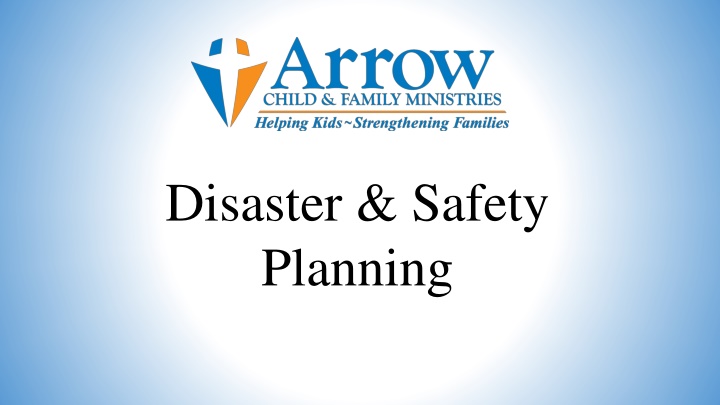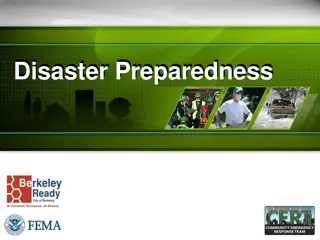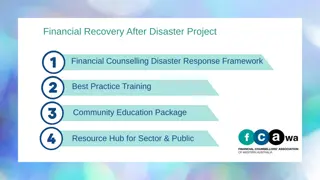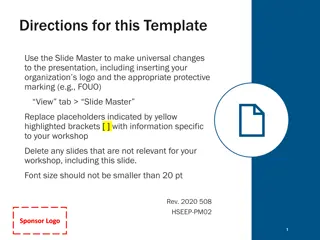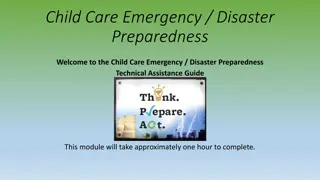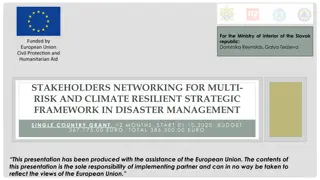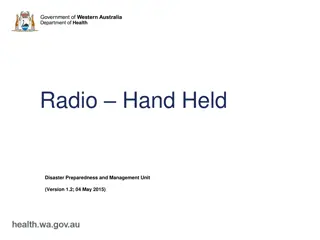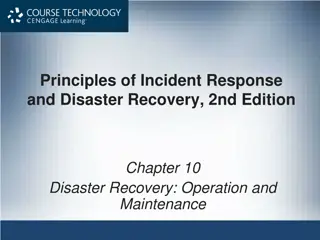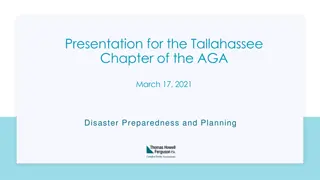Disaster and Safety Planning for Child Care: Ensuring Preparedness and Protection
Valuable insights into the importance of safety planning for children in the event of disasters and emergencies, emphasizing the need for caregivers to maintain written plans, evacuation protocols, and knowledge of handling various types of crises to ensure the safety of children under their care.
Download Presentation

Please find below an Image/Link to download the presentation.
The content on the website is provided AS IS for your information and personal use only. It may not be sold, licensed, or shared on other websites without obtaining consent from the author.If you encounter any issues during the download, it is possible that the publisher has removed the file from their server.
You are allowed to download the files provided on this website for personal or commercial use, subject to the condition that they are used lawfully. All files are the property of their respective owners.
The content on the website is provided AS IS for your information and personal use only. It may not be sold, licensed, or shared on other websites without obtaining consent from the author.
E N D
Presentation Transcript
Disaster & Safety Planning
Safety is the cornerstone in the care of children.
Disaster and Emergency Plans A good safety plan includes designing a disaster plan to deal with any occurrences which render the home or neighborhood unsafe or dangerous.
Disaster and Emergency Plans All homes must maintain a written disaster plan. A current copy of the plan must be maintained and kept in the home, as well as in the family s foster home file.
Disaster and Emergency Plans In the event of an emergency requiring evacuation or quarantine, caregivers are responsible for maintaining the safety of all children in their care.
When to Evacuate Mandatory evacuation if directed by local officials; voluntary evacuation means that children in care must be evacuated from the area and taken to a safe area.
When to Evacuate Each home must have written plans and procedures for handling potential disasters and emergencies, such as fire, severe weather emergencies, and transportation emergencies.
When to Evacuate Caregivers must know the procedures for meeting disasters and emergencies, including evacuation procedures, supervision of the children and contacting emergency help.
Developing a Disaster Plan Types of disasters and emergencies: Fire Flood Hurricane Tornado Heat Thunderstorm Chemical Emergencies Hazardous Material Winter Storm Terrorism
4 Steps to Safety Number 1 Find Out What Could Happen To You By learning what your risks may be, you can prepare for the disaster most likely to occur in your area. Learn more by contacting your local emergency management office of American Red Cross chapter. Be prepared to take notes.
4 Steps to Safety Number 1 Ask the following: What types of disasters are most likely to happen in your community? Identify which human-caused or technological disasters can affect your region, too. Remember to consider major chemical emergencies that can occur anywhere chemical substances are stores, manufactured, or transported.
4 Steps to Safety Number 1 Ask the following: How should you prepare for each type of disaster? Know the response steps to each type of disaster.
4 Steps to Safety Number 1 Ask the following: Does your community have a public warning system? What do your community s warning signals sound like and what should you do when you hear them?
4 Steps to Safety Number 1 Ask the following: If you care for special needs children, how can you help them? What might be some special needs to consider?
4 Steps to Safety Number 1 Ask the following: What are the disaster plans at your workplace, your children s school or day care center, and other places where members of your family spend time? You should be prepared wherever you may be when disaster strikes and learn steps you can take to prevent or avoid disasters.
4 Steps to Safety Number 2 Create a Family Disaster Plan Once you know what disasters are possible in your area, talk about how to prepare and how to respond if one occurs. Make checklists of steps you can take as you discuss this information with your family.
4 Steps to Safety Number 2 How to create your Family Disaster Plan Meet with your family and discuss why you need to prepare for disaster. Explain the dangers of fire, severe weather, and earthquakes to children. Plan to share responsibilities and work together as a team. Keep it simple enough so people can remember the important details. A disaster is an extremely stressful situation that can create confusion. The best emergency plans are those with very few details.
4 Steps to Safety Number 2 How to create your Family Disaster Plan Discuss the types of disasters that are most likely to happen. Explain what to do in each case. Everyone should know what to do in case all family members are not together. Discussing disasters ahead of time will help reduce fear and anxiety and will help everyone know how to respond.
4 Steps to Safety Number 2 Pick 2 places to meet: 1.Right outside of your home in case of a sudden emergency, like a fire. 2.Outside of your neighborhood in case you can't return home or asked to leave your neighborhood. Everyone must know the address and phone number of the meeting locations.
4 Steps to Safety Number 2 Develop an emergency communication plan. In case family members are separated from one another during floods are other disasters, have a plan for getting back together. Separation is a real responsibility during the day when adults are at work and children are at school.
4 Steps to Safety Number 2 Ask an out-of-town relative or friend to be your family contact. Your contacts should live outside of your area. After disaster, it is often easier to make a long-distance call then a local call. Family members should call the contact and tell him or her where they are. Everyone must know the contacts name, address, and phone number.
4 Steps to Safety Number 2 Discuss what to do if authorities ask you to evacuate. Make arrangements for a place to stay with a friend or relative who lives out of town and / or learn about shelter locations.
4 Steps to Safety Number 2 Be familiar with Escape Routes. Depending on the type of disaster, it may be necessary to evacuate your home. Plan several Escape Routes in case certain roads are blocked or closed. Remember to follow the advice of local officials during evacuation situations. They will direct you to the safest route some roads may be blocked or put you in further danger.
4 Steps to Safety Number 2 Plan how to take care of your pets Pets (other than service animals) are not permitted to be in places where food is served, according to many local Health Department regulations. Plan where you would take your pets if you had to go to a public shelter where they are not permitted.
4 Steps to Safety Number 3 Complete your checklists. Take the steps outlined in the checklist you made when you created your family disaster plan. Remember to include the following items on your checklist.
4 Steps to Safety Number 3 Post by phones emergency telephone numbers (fire, police, ambulance, etc.). You may not have time in an emergency to look up critical numbers.
4 Steps to Safety Number 3 Teach all responsible family members how and when to turn off the water, gas, and electricity at the main switches or valves. Keep necessary tools near gas and water shut-off valves. Turn off utilities only if you suspect a leak or damage line, or if you are instructed to do so by authorities.
4 Steps to Safety Number 3 If you turn the gas off, you will need a professional to turn it back on. Paint shutoff valves with white or fluorescent paint to increase visibility. Attach a shut-off valve wrench or other special tool in a conspicuous place close to the gas and water shut-off valves.
4 Steps to Safety Number 3 Check if you have adequate insurance coverage. Ask your insurance agents to review your current policies to ensure that they will cover your home and belongings adequately. Homeowners insurance does not cover flood losses if you are a renter, your landlord's insurance does not protect your personal property it only protects the building.
4 Steps to Safety Number 3 Renter s insurance pays if a renter s property is damaged or stolen. Renter's insurance costs less than $15 a month in most areas of the country. Contact your insurance agent for more information.
4 Steps to Safety Number 3 Install smoke alarms on each level of your home, especially near bedrooms. Smoke alarms cut nearly in half your chances of dying in a home fire.
4 Steps to Safety Number 3 Smoke alarms sense abnormal amounts of smoke or invisible combustion gases in the air. They can detect both smoldering and flaming fires. Many areas are now requiring hard-wired smoke alarms in new homes.
4 Steps to Safety Number 3 Get training from the fire department on how to use your fire extinguisher (A-B-C type). Different extinguishers operate in different ways. Unless responsible family members know how to use your particular model, they may not be able to use it effectively. There is no time to read directions during an emergency. Only adult should handle and use extinguishers.
4 Steps to Safety Number 3 Conduct a home hazard hunt. During a disaster, ordinary objects in your home can cause injury or damage. Anything that can move, fall, break, or cause a fire is a home hazard. For example. During an earthquake or a tornado, a hot water heater or a bookshelf could turn over or pictures hanging over a couch could fall and hurt someone.
4 Steps to Safety Number 3 Look for electrical, chemical, and fire hazards. Contact your local fire department to learn about home fire hazards. Inspect your home at least once a year and fix potential hazards.
4 Steps to Safety Number 3 Stock emergency supplies and assemble a disaster supplies kit. Keep enough supplies in your home to meet your needs for at least 3 days assemble disaster supplies kit with items you may need in case of an evacuation. Store these supplies in sturdy, clearly labeled, easy to carry containers, such as backpacks or duffle bags.
4 Steps to Safety Number 3 Keep a smaller disaster supplies kit in the trunk of your car. If you become stranded or not able to return home, having these items will help you to be more comfortable.
4 Steps to Safety Number 3 Keep a portable, battery operated radio or television and extra batteries. Maintaining a Communications link with the outside is a step that can mean the difference between life and death. Make sure that all family members know where the portable, battery operated radio or television is located, and always keep a supply of extra batteries.
Consider using a NOAA Weather Radio with a tone-alert feature. NOAA (National Oceanic and Atmospheric Administration) weather radio is the best means to receive warnings from the National Weather Service. National Weather Service continuously broadcasts updated weather warnings and forecasts that can be received by NOAA weather radios which are sold in many stores.
NOAA Weather Radio now broadcast warnings and potential and post-event information for all types of Hazards both natural (such as weather and flooding as well as earthquakes and volcanic activity) and technological (such as chemical releases or oil spills).
Working with other federal agencies in the Federal Communications commission's new emergency alert system, NOAA Weather Radio is an all hazards radio network, making it the single source for the most comprehensive weather and emergency information available to the public.
Your National Weather Service recommends purchasing a NOAA Weather Radio that has both a battery backup in a Specific Area Message Encoder (SAME) feature which automatically alerts you when a watch or warning is issued for your county, giving you immediate information about a life-threatening situation. The average range is 40 miles, depending on topography. The NOAA weather radio signal is a line-of-sight signal, which does not bore through hills or mountains.
Keep your certifications current in First Aid and CPR. Have your family learn basic safety measures. Such as CPR and first aid. These are critical skills, and learning can be a fun activity for older children.
Plan home escape routes. Determine the best escape routes from your home in preparation for a fire or other emergency that would require you to leave the house quickly. Find two ways out of each room.
Find the safe places in your home for each type of disaster. Different disasters often require different types of safe places. While basements are appropriate for tornadoes, they could be deadly in a major chemical emergency.
Make two photocopies of vital documents and keep the originals in a safe deposit box. Keep one copy in a safe place in the house, and give the second copy to an out-of-town friend or relative. Vital documents such as birth and marriage certificates, tax records, credit card numbers, financial records, wills and trust can be lost during disasters.
Make a complete inventory of your home, garage, and surrounding property. The inventory can be either written or videotaped. Include information such as serial numbers, make and model numbers, physical descriptions, and price of purchases (receipts, if possible).
This list could help you prove the value of what you own if your possessions are damaged or destroyed and can help you to claim deductions on taxes. Be sure to include expensive items such as sofas, chairs, tables, beds, chests, wall units, and any other furniture too heavy to move. Do this for all items in your home, on all levels. Then throw a copy of the records somewhere away from your home, such as in a safe-deposit box.
4 Steps to Safety Number 4 Practice and maintain your plan. Practicing your plan will help you instinctively make the appropriate response during an actual emergency. You will need to review your plan periodically and you may need to change some parts.
4 Steps to Safety Number 4 Quiz your kids and practice escape routes at least monthly so that they remember what to do, meeting places, phone numbers, and safety rules.
